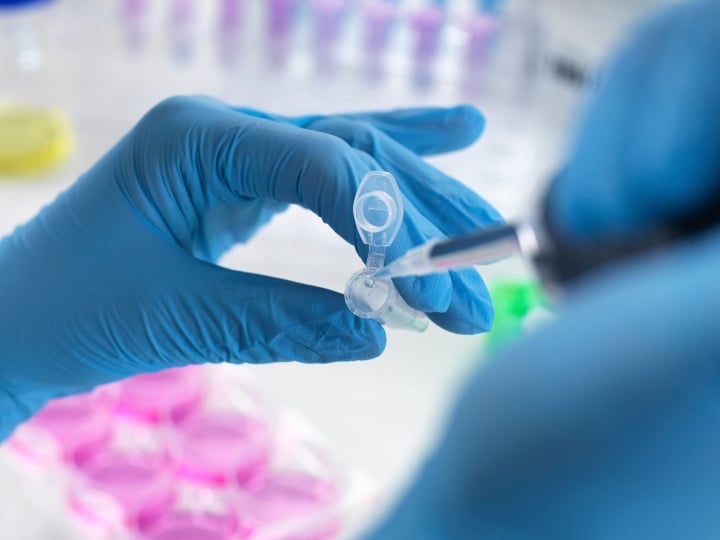Biophysical characterisation of biologics laboratory services – supporting protein development by applying UV, CD, NMR, FTIR, fluorescence, SEC-MALS, AUC, DLS and DSC
The biophysical characterisation of biologics plays an important role in the development of protein therapeutics such as or monoclonal antibodies or biosimilars. The biophysical behaviour of proteins can impact many aspects of biologic drug function, activity, and stability. Biophysical analytical methods can, for example, help to monitor or confirm conformational integrity, the nature of the folded state of the protein and how the peptides associate to form higher order structures. Understanding the interactions between drug substance and excipients – which may potentially alter protein structure and therefore product stability – is important during formulation development, stability studies, and comparability. Biophysical methods can also provide valuable information on protein degradation and aggregation of proteins in solution.
Techniques for Biophysical Characterisation
Our biologics biophysical characterisation experts apply a wide range of techniques to interrogate the biophysical behaviour of your molecule. We examine a product's higher-order structure (HOS), including secondary and tertiary structure, aggregation, oligomerization, and degradation of the drug substance. Moreover, our biophysical programs are phase specific. During pre-formulation, we study the proteins in the environment and behaviour in addition to protein forced degradation studies, and to support formulation development, we study proteins in the buffers and the presence of additives/excipients of interest. To support IND or NDA submissions, we conduct biophysical characterisation studies that assess spectroscopic, thermodynamic, and hydrodynamic properties.
Higher Order Structure Analysis
Our higher-order structure biophysical programs include high-resolution methods such as multi-dimensional nuclear magnetic resonance (NMR) and other spectroscopic techniques such as circular dichroism (CD), fourier transform infrared (FTIR) spectroscopy, differential scanning calorimetry (DSC), second derivative ultraviolet absorbance spectroscopy (UV-vis), and intrinsic fluorescence.
Aggregation Biophysical Studies
Differential scanning calorimetry (DSC), analytical ultracentrifugation (AUC), and light scattering techniques (DLS, SEC-MALS) allows the study of non-covalent structural aspects of a protein, and also study of aggregates or oligomer formation in solution.
Spectroscopic Profiles for Protein Characterisation (ICH Q6B)
To establish spectroscopic profiles to support protein characterisation physico-chemical programs, we apply ultraviolet and visible absorption spectra, circular dichroism (CD), nuclear magnetic resonance (NMR), infrared (FTIR), or fluorescence spectroscopy.
Biophysical Characterisation Expertise
Our expertise in biophysical characterisation can support your product development process. With expertise across a wide range of product types including proteins, monoclonal antibodies, vaccines, PEGylated proteins, antibody drug conjugates, oligonucleotides, glycoproteins, and biosimilars, we can apply a wide range of biophysical technologies to deliver efficient and detailed information. As an industry leader in scientific and technical leadership, we can help you advance your biopharmaceutical development programs with expert project management and regulatory guidance. Bringing quality and safety to life, we apply our Total Quality Assurance expertise to help you to meet and exceed quality, safety, and regulatory standards for your biologic development programs.
Intrinsic fluorescence assays use the fluorescence emission by aromatic amino acids tryptophan, tyrosine or phenylalanine to provide information about the tertiary structure of a protein. Tryptophan fluorescence, in particular, is sensitive to the local environment around Tryptophan and can be used to monitor changes in the tertiary structure of a protein making it a very useful method for formulation development, stability or comparability studies.

COVID-19 VACCINE OR THERAPEUTIC TESTING & DEVELOPMENT SUPPORT
IMMEDIATE QUESTION? Ask our experts now
FACTSHEET: COVID-19 Vaccine or Therapeutic Testing & Development Outsourcing
ARTICLE: Repurposing Vaccines for Intranasal Development
WEBINAR: Quality Control Strategy for Vaccine Development
WEBINAR: Repurposing Drugs for Inhaled Delivery
eBOOK: Contingency Outsourcing Solutions
ARTICLES
New Approaches to Bioassay Design
Characterisation of Bispecifics
The Significance and Challenges of Inhaled and Nasal Biologics
Current Analytical Approaches to Biophysical Characterisation
Biosimilar Characterisation and Immunogenicity
WHITEPAPER DOWNLOADS
Liposome Physicochemical Property Analysis
Formulation of Biologics for Inhaled and Nasal Delivery
The Complexities of Antibody Drug Conjugate Characterization
BROCHURES
Download: Intertek Biopharmaceutical Services Brochure
Download: Intertek Pharmaceutical Services

